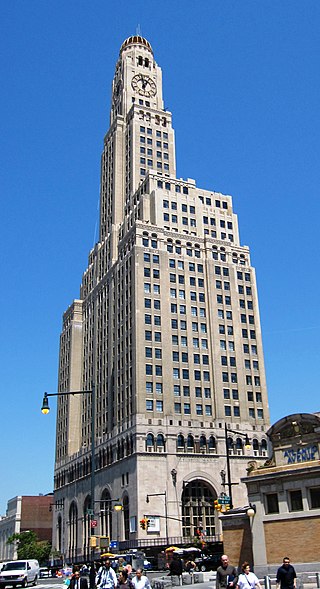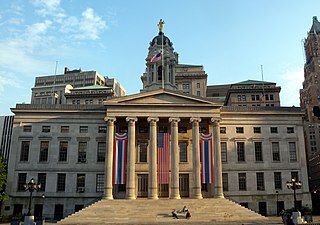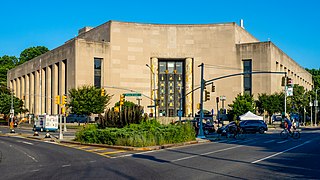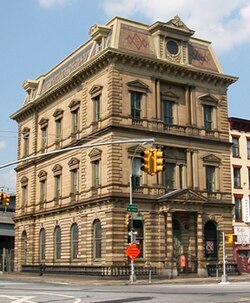
Greenpoint is the northernmost neighborhood in the New York City borough of Brooklyn, in the U.S. state of New York. It is bordered on the southwest by Williamsburg at Bushwick Inlet Park and McCarren Park; on the southeast by the Brooklyn–Queens Expressway and East Williamsburg; on the north by Newtown Creek and the neighborhood of Long Island City in Queens; and on the west by the East River. The neighborhood has a large Polish immigrant and Polish-American community, containing many Polish restaurants, markets, and businesses, and it is often referred to as Little Poland.

Cobble Hill is a neighborhood in the northwestern portion of the New York City borough of Brooklyn. A small neighborhood comprising 40 blocks, Cobble Hill sits adjacent to Brooklyn Heights to the north, Boerum Hill to the east, Carroll Gardens to the south, and the Columbia Street Waterfront District to the west. It is bounded by Atlantic Avenue (north), Court Street (east), Degraw Street (south) and the Brooklyn Queens Expressway (west). Other sources add to the neighborhood a rectangle bounded by Wyckoff Street on the north, Hoyt Street on the east, Degraw Street on the south, and Court Street on the west.

Terrance Lindall is an American artist and the co-director and chief administrator of the Williamsburg Art and Historical Center in Brooklyn, New York. Lindall's illustrations have been published in Heavy Metal, Creepy, Eerie and Vampirella, among others.

Yuko Nii is a Japanese artist and philanthropist. Her work has included painting, printmaking, graphic design, stage set, costume and fashion design. She has written journalism, poetry, fiction, essays and philosophy, and published two books. She also runs the non-profit organization Yuko Nii Foundation.

The Williamsburgh Savings Bank Tower, also known as One Hanson Place, is a skyscraper in the Fort Greene neighborhood of Brooklyn in New York City. Located at the northeast corner of Ashland Place and Hanson Place near Downtown Brooklyn, the tower is one of Brooklyn's architectural icons. The tower was designed by Halsey, McCormack and Helmer and constructed from 1927 to 1929 as the new headquarters for the Williamsburgh Savings Bank. From the time of its construction until 2009, One Hanson Place was the tallest building in Brooklyn at 41 stories and 512 feet (156 m) tall.

The Williamsburgh Savings Bank was a financial institution in Brooklyn, New York from the mid-19th to the mid-20th centuries. The bank was incorporated in 1851 under legislation passed by the New York State Assembly. The bank continued to operate until a series of mergers brought the bank into the HSBC group late in the 20th century.

Brooklyn Borough Hall is a building in Downtown Brooklyn, New York City. It was designed by architects Calvin Pollard and Gamaliel King in the Greek Revival style, and constructed of Tuckahoe marble under the supervision of superintendent Stephen Haynes.

Belle Air Plantation is an estate located on the north bank of the James River in Charles City County, Virginia, United States. It is located along State Route 5, a scenic byway which runs between the independent cities of Richmond and Williamsburg. Belle Air is listed on the National Register of Historic Places.

William H. Willcox was an American architect and surveyor who practised in Brooklyn and New York (1850s-70), Chicago, Illinois, Nebraska (1879–82), St. Paul, Minnesota (1882–91), Seattle, Washington (1891–95), Los Angeles (1895–98) and San Francisco (1898-1912?).

The Greenwich Savings Bank was an American savings bank based in New York City that operated from 1833 to 1981. At the time of its closure in 1981, it was the 16th largest bank in the U.S. by total deposits.

The Williamsburg Houses, originally called the Ten Eyck Houses, is a public housing complex built and operated by the New York City Housing Authority (NYCHA), in the Williamsburg neighborhood of Brooklyn. It consists of 20 buildings on a site bordered by Scholes, Maujer, and Leonard Streets and Bushwick Avenue. The Williamsburg Houses were built in 1936–1938 under the auspices of the Housing Division of the Public Works Administration (PWA). Richmond Shreve was the chief architect of the project; the design team of nine other architects was led by the Swiss-American modernist William Lescaze. The construction contract was awarded to Starrett Brothers & Eken. The designs called for the inclusion of modern art commissioned through the Federal Arts Project.

49 Chambers, formerly known as the Emigrant Industrial Savings Bank Building and 51 Chambers Street, is a residential building at 49–51 Chambers Street in the Civic Center neighborhood of Manhattan in New York City. It was built between 1909 and 1912 and was designed by Raymond F. Almirall in the Beaux-Arts style. The building occupies a slightly irregular lot bounded by Chambers Street to the south, Elk Street to the east, and Reade Street to the north.

The Jamaica Savings Bank was a bank incorporated in 1866 in the Jamaica section of the borough of Queens in New York City. It had four branches across Queens before it was acquired by North Fork Bank in 1999, which itself was acquired by Capital One Bank in 2008.

The Jamaica Center for Arts & Learning in Jamaica, Queens, New York is a performing and visual arts center that was founded in 1972 in an effort to revitalize the surrounding business district. As of 2012, it serves more than 28,000 people annually via a 1,650 square foot gallery, a 99-seat proscenium theater, and art & music studios. The building that houses the center is the former Queens Register of Titles and Deeds Building, a New York City landmark that is also listed on the National Register of Historic Places. Outside the building is one of only two remaining cast-iron sidewalk clocks in New York City, as well as a late-Victorian era headquarters of the Jamaica Savings Bank next door.
This is a timeline and chronology of the history of Brooklyn, New York. Brooklyn is the most populous of New York City's boroughs, and was settled in 1646.

The Central Library is the main branch of the Brooklyn Public Library, located at Flatbush Avenue and Eastern Parkway on Grand Army Plaza in Brooklyn, New York City. It contains over a million cataloged books, magazines, and multimedia materials. Each year, over one million people visit the library. The building is a designated New York City landmark.

The Brooklyn Tower is a supertall mixed-use, primarily residential skyscraper in the Downtown Brooklyn neighborhood of New York City. Developed by JDS Development Group, it is situated on the north side of DeKalb Avenue near Flatbush Avenue. The main portion of the skyscraper is a 93-story, 1,073-foot (327 m) residential structure designed by SHoP Architects. Preserved at the skyscraper's base is the Dime Savings Bank Building, designed by Mowbray and Uffinger, which dates to the 1900s.

The Brooklyn Fire Department (BFD) was a professional fire department that provided fire protection and rescue services to the city of Brooklyn, New York, within modern-day New York City, from 1869 to 1898. The Brooklyn Fire Department, a paid firefighting force, replaced a 3,000-person volunteer fire department that was poorly equipped to serve Brooklyn's growing population.

The Williamsburgh Savings Bank Building, also known as the Weylin and 175 Broadway, is a former bank building at 175 Broadway in the Williamsburg neighborhood of Brooklyn in New York City. Constructed as the headquarters of the Williamsburgh Savings Bank in 1875 and subsequently expanded several times, it occupies the northwest corner of Broadway and Driggs Avenue, just south of the Williamsburg Bridge. The Williamsburgh Savings Bank Building was designed in the Classical Revival style by George B. Post, with interiors by Peter B. Wight.

Kenichi Nakajima is a Japanese painter, visual artist, and performance artist. He is known for his exhibitions at the Williamsburg Art & Historical Center, including the group exhibitions Life on Earth and Togetherness and Oneness. He has also participated in exhibitions such as The Right to Silence? at the Anya and Andrew Shiva Gallery and the solo exhibition From FEET to Art.























